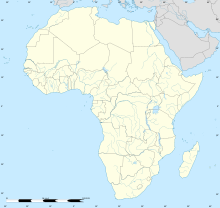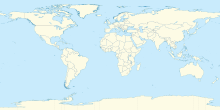Williamson diamond mine
 Williamson Diamonds Limited | |
| Location | |
|---|---|
| Country | Tanzania |
| Coordinates | 03°31′S 033°36′E / 3.517°S 33.600°E |
| Production | |
| Products | Diamonds (300,000 carats per annum) |
| History | |
| Opened | 1940 |
| Owner | |
| Company | Petra Diamonds (75%) Government of Tanzania (25%) |
The Williamson Diamond Mine (also known as the Mwadui mine) is a
The Williamson mine was once owned by its namesake Williamson and later nationalized by the government of Tanzania. Since February 2009 the mine is mostly owned by Petra Diamonds, with 75% ownership, the government of Tanzania owning the remaining 25%.[3] In 2020, the mine came under scrutiny because of alleged human rights violations.[2]
Description
The Williamson diamond mine is a large

Location
The mine is located about 160 kilometers (99 mi) south of the town of Mwanza in Kishapu District of Shinyanga Region. Williamson, the discoverer of the site, first owner and namesake of the mine, named the site "Mwadui" after a local chief; "Williamson" and "Mwadui" are now virtually synonymous in the diamond mining world.
Geology
The most important geological feature of the Williamson diamond mine is the
Production
The Williamson diamond mine is now characterized by low
Notable stones produced at the Williamson mine include the 54.5 carats (10.90 g)
History

The
Williamson's heirs sold the mine
Since 1994, De Beers has acted to improve the performance of the Williamson diamond mine by trimming the work force, making capital investment in equipment, and bringing in expertise in technology, technique, and exploration. Although the mine is still viewed as a marginal performer due to its low ore grade, De Beers has identified avenues for development that would keep the mine operating into the future.
In September 2008, Petra Diamonds Ltd agreed to acquire the Williamson Mine from De Beers and completed the acquisition in February 2009.
In April 2020, the mine was mothballed after the collapse of diamond prices.
Although in February 2021 Petra & the Tanzanian Government entered discussions to reopen the mine in Q4 2021, but that did not happen.
In September 2021 Petra announced that it was seeking a buyer for the mine. Confirming news reports from March, when the company prospectus described the mine as permanently closed.
Recreation
The mine was equipped with a range of sporting facilities. These included public swimming pool, tennis and squash courts, soccer field, athletics track, golf course and yacht club. There was also a surgical hospital staffed by two English and an Indian doctor and nursing staff. The hospital used to treat the mine employees for free, and poor people from neighbouring areas could take treatment there at nominal charges. These facilities fell into disrepair after the colonial era, but remain partly maintained by the mine.
Incidents
2020 human rights allegations
A lawsuit against for human rights violations by guards was filed in May 2020 in the
References
- ^ a b c d Patricia Treble (May 31, 2012). "One of the Queen's favourite brooches has Canadian roots". Macleans.ca.
- ^ a b c d "Mine that produced Queen's diamond investigates claims of abuses by guards". the Guardian. 2021-03-05. Retrieved 2021-04-18.
- ^ "Williamson Mine". Petra Diamonds. Retrieved 1 February 2016.
- ^ Gunther, John (1957). Inside Africa. The Reprint Society. p. 420.
- ^ "Allegations of human rights abuses at the Williamson mine". Petra Diamonds. Retrieved 2021-04-18.
- ^ "Petra Diamonds probes new claims of human rights abuses in Tanzania". MINING.COM. 2021-02-09. Retrieved 2021-04-18.
- ^ "Guards at Petra Diamonds' Tanzanian Mine deliberately modified ammunition to inflict greater damage". Raid. Retrieved 2021-04-18.
- ^ "Petra Diamond's says it is investigating allegations of human rights abuses from RAID". Business & Human Rights Resource Centre. Retrieved 2021-04-18.
- ^ "Petra Diamonds probes new claims of human rights abuses in Tanzania". MINING.COM. 2021-02-09. Retrieved 2021-04-18.
Sources
- Tassell, Arthur. African Mining Magazine. "Williamson – A Bright Future Ahead?" Archived 2005-04-10 at the Wayback Machine. Brooke Pattrick Publications.
- De Beers Group official website. "De Beers Group: Tanzania" Archived 2008-05-18 at the Wayback Machine. Retrieved April 18, 2005.
- Knight, John; Stevenson, Heather (September 1986). "The Williamson Diamond Mine, De Beers, and the Colonial Office: A Case-Study of the Quest for Control". Journal of Modern African Studies. 24 (3). Cambridge University Press: 423–445. S2CID 154665289.
- Chopra, Jarat. "Tanganyika Diamond Presented to Princess Elizabeth," Old Africa, No. 21 (February–March 2009) 16–17.
- Chopra, Jarat. "Princess Margaret Hosted in Mwanza," Old Africa, No. 22 (April–May 2009) 20–22.
- Williamson, John Thorburn. "The Williamson Diamond Mine", pages 99-112 in "Rhodesia and East Africa", compiled and edited by F.S. Joelson, published in 1958 by East Africa and Rhodesia, London. "Dr. Williamson died shortly after writing this account, the only one which he ever wrote for publication."



